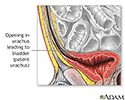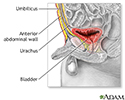Patent urachus repair
Patent urachal tube repair
Patent urachus repair is surgery to fix a bladder defect. In an open (or patent) urachus, there is an opening between the bladder and the belly button (navel). The urachus is a tube between the bladder and the belly button that is present before birth. In most cases, it closes along its full length before the baby is born. An open urachus occurs mostly in infants.
Description
Children who have this surgery will have general anesthesia (asleep and pain-free).
General anesthesia
General anesthesia is treatment with certain medicines that puts you into a deep sleep so you do not feel pain during surgery. After you receive the...
The surgeon will make a cut in the child's lower belly. Next, the surgeon will find the urachal tube and remove it. The bladder opening will be repaired, and the cut will be closed.
The surgery can also be done with a laparoscope. This is an instrument that has a tiny camera and light on the end.
- The surgeon will make three small surgical cuts in the child's belly. The surgeon will insert the laparoscope through one of these cuts and other tools through the other cuts.
- The surgeon uses the tools to remove the urachal tube and close off the bladder and area where the tube connects to the umbilicus.
This surgery can be done in children as young as 6 months.
Why the Procedure Is Performed
Surgery is recommended for a patent urachus that does not close after birth. Problems that can occur when a patent urachal tube is not repaired include:
- A higher risk for urinary tract infections
- A higher risk for cancer of the urachal tube later in life
- Continued leakage of urine from the urachus
Risks
Risks for any anesthesia are:
- Reactions to medicines
-
Breathing problems
Breathing problems
Breathing difficulty may involve:Difficult breathingUncomfortable breathingFeeling like you are not getting enough air
 ImageRead Article Now Book Mark Article
ImageRead Article Now Book Mark Article
Risks for any surgery are:
-
Bleeding
Bleeding
Bleeding is the loss of blood. Bleeding may be:Inside the body (internally) Outside the body (externally)Bleeding may occur:Inside the body when blo...
 ImageRead Article Now Book Mark Article
ImageRead Article Now Book Mark Article - Infection
-
Blood clots
in the legs that may travel to the lungs
Blood clots
Blood clots are clumps that occur when blood hardens from a liquid to a solid. A blood clot that forms inside one of your veins or arteries is calle...
 ImageRead Article Now Book Mark Article
ImageRead Article Now Book Mark Article
Additional risks for this surgery are:
-
Bladder infection
Bladder infection
A urinary tract infection, or UTI, is an infection of the urinary tract. The infection can occur at different points in the urinary tract, including...
 ImageRead Article Now Book Mark Article
ImageRead Article Now Book Mark Article - Bladder leaks -- if this happens, a catheter (thin tube) is inserted into the bladder to drain urine. It is left in place until the bladder heals
Before the Procedure
The surgeon may ask for your child to have:
- A complete medical history and physical exam
- Kidney ultrasound
- Sinogram of the urachus. In this procedure, a radio-opaque dye called contrast is injected into the urachal opening and x-rays are taken.
- Ultrasound of the urachus
- VCUG (voiding cystourethrogram), a special x-ray to make sure the bladder is working
Always tell your child's health care provider:
- What drugs your child is taking. Include drugs, herbs, vitamins, or any other supplements you bought without a prescription.
- About any allergies your child may have to medicine, latex, tape, or skin cleaner.
During the days before the surgery:
- About 10 days before the surgery, you may be asked to stop giving your child aspirin, ibuprofen (Advil, Motrin), naproxen (Aleve, Naprosyn), warfarin (Coumadin), and any other drugs that make it hard for blood to clot.
- Ask which drugs your child should still take on the day of the surgery.
On the day of the surgery:
- Your child will probably not be able to drink or eat anything for 4 to 8 hours before surgery.
- Give your child any drugs you have been told your child should have with a small sip of water.
- Your child's provider will tell you when to arrive at the hospital.
- The provider will make sure your child has no signs of illness before surgery. If your child is ill, the surgery may be delayed.
After the Procedure
Most children stay in the hospital for just a few days after this surgery. Most recover rapidly. Children can eat their normal foods once they start eating again.
Before leaving the hospital, you will learn how to care for the wound or wounds. If Steri-Strips were used to close the wound, they should be left in place until they fall off on their own in about a week.
You may get a prescription for antibiotics to prevent infection, and for a safe medicine to use for pain.
Outlook (Prognosis)
The outcome is most often excellent.
References
Frimberger D, Kropp BP. Bladder anomalies in children. In: Wein AJ, ed. Campbell-Walsh Urology . 10th ed. Philadelphia, PA: Elsevier Saunders; 2011:chap 125.
-
Patent urachus - illustration
During fetal development the urachus is a tube that connects the bladder to the umbilicus. After birth, the urachus normally closes and becomes a ligament. If the urachus remains open, surgery is recommended so that bacteria or infection cannot be introduced into the bladder.
Patent urachus
illustration
-
Patent urachus repair - series
Presentation
-
Patent urachus - illustration
During fetal development the urachus is a tube that connects the bladder to the umbilicus. After birth, the urachus normally closes and becomes a ligament. If the urachus remains open, surgery is recommended so that bacteria or infection cannot be introduced into the bladder.
Patent urachus
illustration
-
Patent urachus repair - series
Presentation
Review Date: 1/21/2015
Reviewed By: Scott Miller, MD, urologist in private practice in Atlanta, GA. Also reviewed by David Zieve, MD, MHA, Isla Ogilvie, PhD, and the A.D.A.M. Editorial team.







